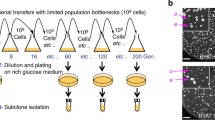Summary
We examined Ty-mediated genomic rearrangements in three related mitotically dividing haploid yeast strains having the same configuration of Ty elements in the CYC1-sup4 interval of chromosome X. Surprisingly, quite different types and frequencies of rearrangements were found in the three strains. In one strain we found only Ty-mediated deletions, which occurred with a frequency of about 1×10-6. Another strain yielded similar deletions, but approximately one-third of these were accompanied by adjacent Ty-mediated inversions. A third strain was found to have an extremely high rate of inversion/reinversion between two of the three Ty elements. This rate was conservatively estimated to be 1.4±0.2×10-2 per cell per generation, which is at least 2 orders of magnitude higher than previously reported values for Ty-mediated rearrangements. These data provide evidence that local regions of the genome can, in some cases, be much more fluid than had been previously believed.
Similar content being viewed by others
References
Baltimore D (1985) Retroviruses and retrotransposons: The role of reverse transcription in shaping the eukaryotic genome. Cell 40:481–482
Boeke JD, Garfinkel DJ, Styles CA, Fink GR (1985) Ty elements transpose through an RNA intermediate. Cell 40:491–500
Calabretta B, Robberson DJ, Barrera-Saldana HA, Lambrou TP, Saunders GF (1982) Genome instability in a region of human DNA enriched in Alu repeat sequences. Nature 296:219–225
Cameron JR, Loh EY, Davis RW (1979) Evidence for transposition of dispersed repetitive DNA families in yeast. Cell 16:739–751
Chaleff DT, Fink GR (1980) Genetic events associated with insertion mutation in yeast. Cell 21:227–237
Ciriacy M, Williamson VM (1981) Analysis of mutations affecting Ty-mediated gene expression in Saccharomyces cerevisiae. Mol Gen Genet 182:159–163
Davis RW, Botstein D, Roth JR (1980) Advanced bacterial genetics. Cold Spring Harbor Laboratory Press, New York, pp 174–176
Downs KM, Brennan G, Liebman SW (1985) Deletions extending from a single Ty1 element in Saccharomyces cerevisiae. Mol Cell Biol 5:3451–3457
Eibel H, Gafner J, Stotz A, Philippsen P (1981) Characterization of the yeast mobile element Ty1. Cold Spring Harbor Symp Quant Biol 45:609–617
Engels WR, Preston CR (1984) Formation of chromosome rearrangements by P factors in Drosophila. Genetics 107:657–678
Fedoroff NY (1983) Controlling elements in maize. In: Shapiro JA (ed) Mobile genetic elements. Academic Press, New York, 1–63
Gafner J, DeRobertis EM, Philippsen P (1983) Delta sequences in the 5′ non-coding region of yeast tRNA genes. EMBO J 2:583–591
Garfinkel DJ, Boeke JD, Fink GR (1985) Ty element transposition: reverse transcriptase and virus-like particles. Cell 42:507–517
Kleckner N, Ross DG (1980) recA-dependent genetic swith generated by transposon Tn10. J Mol Biol 144:215–221
Lea DE, Coulson CA (1949) The distribution of numbers of mutants in bacterial populations. J Genet 49:264–285
Liebman SW, Picologlou S (in press) Recombination associated with yeast retrotransposons. In: Koltin Y, Leibowitz MJ (eds) Viruses of fungi and simple eukaryotes. Marcel Dekker, New York, pp 63–90
Liebman SW, Singh A, Sherman F (1979) A mutator affecting the region of the iso-1-cytochrome c gene in yeast. Genetics 92:783–803
Liebman SW, Shalit P, Picologlou S (1981) Ty elements are involved in the formation of deletions in DEL1 strain of Saccharomyces cerevisiae. Cell 26:401–409
Malone RE, Golin JE, Esposito MS (1980) Mitotic versus meiotic recombination in Saccharomyces cerevisiae. Curr Genet 1:241–248
Maniatis T, Fritsch EF, Sambrook J (1982) Molecular cloning. Cold Spring Harbor Laboratory Press, New York, p 170
Roeder GS, Fink GR (1980) DNA rearrangements associated with a transposable element in yeast. Cell 21:239–249
Roeder GS, Fink GR (1983) Transposable elements in yeast. In: Shapiro JA (ed) Mobile genetic elements. Academic Press, New York, pp 300–328
Roeder GS, Smith M, Lambie EJ (1984) Intrachromosomal movement of genetically marked Saccharomyces cerevisiae transposons by gene conversion. Mol Cell Biol 4:703–711
rothstein R (1979) Deletions of a tyrosine tRNA gene in S. cerevisiae. Cell 17:185–190
Rothstein R, Helms C, Rosenberg N (1987) Concerted deletions and inversions are caused by mitotic recombination between delta sequences in Saccharomyces cerevisiae. Mol Cell Biol 7:1198–1207
Rubin GM (1983) Dispersed repetitive DNAs in Drosophila. In: Shapiro JA (ed) Mobile genetic elements. Academic Pres, New York, pp 329–361
Sanger F, Nicklen S, Coulson AR (1977) DNA sequencing with chain terminating inhibitors. Proc Natl Acad Sci USA 74:5463–5467
Sapienza C, Rose MR, Doolittle WF (1982) High-frequency genomic rearrangements involving archaebacterial repeat sequence elements. Nature 299:182–185
Shalit P (1981) Physical analysis of the deletor phenomenon in Saccharomyces cerevisiae. Ph.D. thesis, University of Washington, Seattle, Washington
Shalit P, Loughney K, Olson MV, Hall BD (1981) Physical analysis of the CYC1-sup4 interval in Saccharomyces cerevisiae. Mol Cell Biol 1:228–236
Sherman F, Slonimski P (1964) Respiration-deficient mutants of yeast II. Biochim Biophys Acta 90:1–15
Sherman F, Stewart JW, Jackson M, Gilmore RA, Parker JH (1974) Mutants of yeast defective in iso-1-cytochrome c. Genetics 77:255–284
Sherman F, Fink GR, Lawrence CW (1979) Methods in yeast genetics: a laboratory manual. Cold Spring Harbor Laboratory Press, New York
Sherman F, Stiles JJ, Friedman LR, Ernst JF, McKnight GL (1982) Divergent and concerted evolution of the two regions encompassing the iso-1-cytochrome c and iso-2-cytochrome c genes of yeast. Stadler Symp 14:111–131
Southern EM (1975) Detection of specific sequences among DNA fragments separated by gel electrophoresis. J Mol Biol 98:503–517
Author information
Authors and Affiliations
Additional information
Communicated by G.R. Smith
Rights and permissions
About this article
Cite this article
Picologlou, S., Dicig, M.E., Kovarik, P. et al. The same configuration of Ty elements promotes different types and frequencies of rearrangements in different yeast strains. Mol Gen Genet 211, 272–281 (1988). https://doi.org/10.1007/BF00330604
Received:
Issue Date:
DOI: https://doi.org/10.1007/BF00330604




